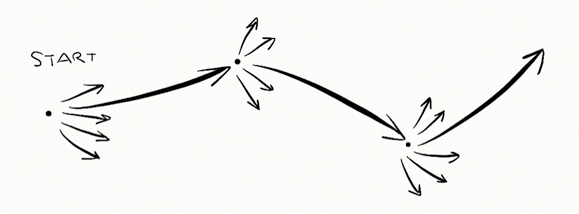Vijay Sundaram takes the concept of technical debt and applies it to User Experience Design:
You know you’re a subprime borrower when your team decides to “clean this up next release”. But the next release has a backlog of critical bug fixes, must-have feature requests, and of course plenty of new design shortcuts that emerge in the process. What’s more, the usage data for the last release is showing great engagement and no one has complained yet about the shortcuts you took. Fixing those can’t possibly be a priority right now. Before long, the team is grafting one design shortcut onto another, and the only way to unwind them is a wholesale reboot.
The article made me think of Henrik Kniberg’s excellent Good and Bad Technical Debt (and how TDD helps), in which he explains the concepts of a “good mess” and the “technical debt ceiling”:
A fresh mess is not a problem. It’s the old mess that bites you. […]
If you are coding up a new feature, there are lots of different ways to do it. Somewhere there is probably a very simple elegant solution, but it’s really hard to figure it out upfront. It’s easier to experiment, play around, try some different approaches to the problem and see how they work. […]
The problem is, just like in the kitchen, we often forget to clean up before moving on. And that’s how technical debt goes bad. All that “temporary” experimental code, duplicated code, lack of test coverage — all that stuff will really slow you down later when you build the next feature.
So regardless of your reason for accumulating short-term debt, make sure you actually do pay it off quickly.
I’ve been wondering how this applies to UX debt. Is it ok to take some design shortcuts, knowing that you’ll come back later and fix it (up to a “UX debt ceiling”)? My gut feeling is to say no, because design is so path-dependent. Your early choices constrain your later design choices, so if you make the wrong choice it can really hurt down the line. For example, if you skip user research in the beginning of the project, you’re highly likely to make the wrong choice about what to build, which isn’t something you can fix easily later on.
The solution is to have shorter UX (and development) cycles, which is becoming commonplace anyway with the rise of the Lean movement. I’m reminded of IDEO Design Director David Aycan’s 2010 article in HBR, Don’t Let the Minimum Win Over the Viable, in which he explains the importance of taking small steps so that it’s easier to correct course when you realise you’re on the wrong track:
Sketching or mocking up experiential prototypes and then testing them with consumers or potential partners, while also explicitly jotting down your operating and business assumptions and using them to discuss the business with industry experts, allows you both to pick a promising route to invest in the development sprint and to pivot with confidence. For example, by prototyping multiple consumer experiences and business models before investing in an initial MVP, GoGo was able to launch an airline WiFi and in-flight service experience that combined the best of multiple alternative services that might be offered in flight. One might think of this approach as testing multiple MVPs in parallel.
Creating multiple options in tandem creates more confidence in the core variables, which in turn means that pivots may be less drastic or disruptive later on. This approach can be applied beyond product features to business models and operating approaches as well.
He uses this sketch to illustrate the approach:

This makes a lot of sense in the context of UX and technical debt as well. A pragmatic approach to dealing with software debt seems to be something like this:
- Create different possible paths (variation)
- Pick a direction and work towards it (iteration)
- Get feedback, address debt and other issues, correct course if necessary
- Repeat cycle
The trick is to be ok with the early messes, but not let them deteriorate so much that you’re unable to clean things up when you finally decide it’s time. Remember the broken windows theory: “maintaining and monitoring urban software environments in a well-ordered condition may stop further vandalism neglegence and escalation into more serious crime technical issues.”